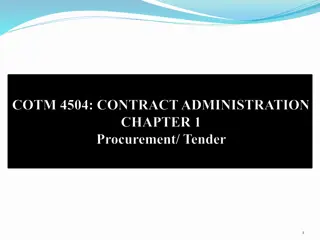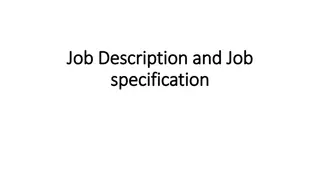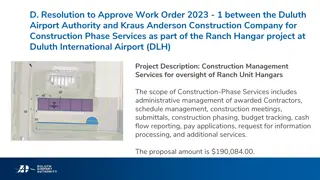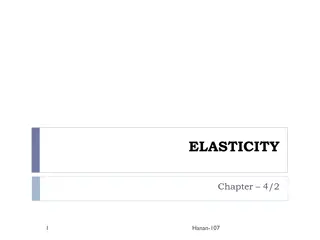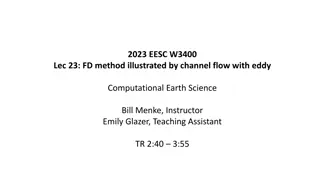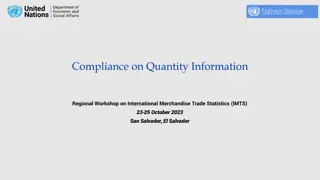Understanding Specification and Quantity Survey in Construction Projects
Specification in construction projects is a detailed written description of materials, workmanship, and instructions for executing tasks. Specifications complement drawings and serve as contract documents, guiding contractors on materials, methods, standards, and project requirements.
Download Presentation

Please find below an Image/Link to download the presentation.
The content on the website is provided AS IS for your information and personal use only. It may not be sold, licensed, or shared on other websites without obtaining consent from the author. Download presentation by click this link. If you encounter any issues during the download, it is possible that the publisher has removed the file from their server.
E N D
Presentation Transcript
AUWC SPECIFICATION AND QUANTITY SURVEY CHAPTER 1 SPECIFICATION October 2019 Organized by Eshetu Ts.
SPECIFICATION CONTENTS Introduction Purpose of specification Types of specification Specification Writing Reference for specification writing Specification Language Guidelines
1. Introduction specification :-is defined as the designation or statement by which written instructions are given distinguishing and/or limiting and describing the particular trade of work to be executed. In short Specification is a statement of particular instructions of how to execute some task. In terms of an engineering project a specification contains a detailed written description of the quality of materials and workmanship necessary to complete the work.
Conti Specification is one of the contract documents. Specifications are written based on the prepared: design, drawings, general and scientific trends of workmanship, quality expected, equipment involved and materials to be used for the particular trade of work The information that is needed for construction is usually conveyed by two basic communication lines. They are Drawings (pictorial) and Specifications (written).
Conti Specifications are devices for organizing the information depicted on the drawings and they are written descriptions of the legal and technical requirements forming the contract documents. Drawings: should generally show the following: Dimensions, extents, size, shape, and location of component parts Location of materials, machineries, and fixtures Interaction of furniture, equipments and space Schedules of finishes, windows and doors The drawings with the specification will give complete requirements of the structure
Conti The specifications should clearly specify: - Type and quality of materials, equipments, labor or workmanship Methods of fabrication, installation and erection Standards, codes and tests Allowance, submittals and substitutions Cost included, insurance and bonds Project records and site facilities. Specifications should be clear, concise, and brief descriptions of what is required to execute the proposed trade of work.
2. Purpose of Specification The purpose of specifications generally includes: Guide the bidder at the time of tendering to arrive at a reasonable cost for the work. Provide guidance for execution and supervision of works. Guide the contractor for the purchase of materials Serve as a part of contract document to limit and describe the rights and obligations of each contracting parties. Guide the bidder to identify his capacity to execute the work. Serve as fabrication and installation guide for temporary and permanent works.
Conti Guide the contractor for the purchase and/or hiring of equipments. Serve for the owner to know what he/she is entitled to receive Serve for the manufacturers of construction materials, equipments, tools etc to grade, classify, and improve qualities of their produces. Indirectly, the specifications are very much related to the legal considerations, insurance considerations, bidding requirements, alternates and options, rights, obligations and remedial measures for the contracting parties. Note: In the events of conflicts between specification and drawings, the specification governs.
Conti Main purposes: 1. help the estimator to price the work. 2. It will become a tendering a contract document & must therefore free of ambiguities 3. It must be a management document to inform the contractor of exactly what work is physically to be performed on site and to assist quantity surveyor/engineer in their cost control function 4. seek to ensure that materials and workmanships achieve an acceptable standard of quality, describes the work to be done
3. Type of Specification General specification In general, specifications can be broadly classified into four categories as follows: A. Manufacturer s specification: Manufacturers prepare specification of their product for the guidance of their users, which may include property description and installation guide lines. B. Guide Specification: Specifications prepared by an individual or group of individuals based on manufacturer s specifications, established trends of workmanship, service and laboratory tests and research findings to be used as guide lines for preparation of contract specifications.
Conti. C. Standard Specification: Specifications which are intended to be used as a reference standard in the construction of a project. The guide specification which has been standardized by a recognized authority is considered as standard specification. D. Contract (Project) Specification: the specification prepared for a particular project to accompany the drawings and other contract documents.
Conti. The specifications described above can be prepared following the format which has general and specific parts(General Specification and Specific Specification). In the general part of the specification the following items are included: Administrative and Procedural Requirements; Scope, definition; Reference Organization and Standards; Project Description, site facilities; Submittal sand quality assurance; Delivery, storage and handling; and Project records, Insurances other general requirements
Conti. In the specific part of the standard specification the following are included: Detailed description of the quality of items to be used; and Preparatory actions and methods of incorporating the items.
Conti. Compliance or Conformance Classification Specification can also be classified as Material and Workmanship Specification and Performance Specification. Material and Workmanship Specifications This form of specification includes: The description of the scope of the works; The general and specific requirements that are necessary for the execution of the work; Material requirements; Construction details; and Method of measurement and payments for completed works.
Conti. A. Material Specifications These descriptions generally include: Physical properties, such as strength, durability, hardness, and electricity; Chemical composition; Electrical and thermal and acoustical properties; and Appearance including color, texture, pattern and finishes
Conti. B. Workmanship Specifications It describes the desired results that need to be achieved in the works which include: Specify the desired results as to the quality of workmanship; State any detailed construction methods or procedures necessary for the accomplishment of particular purposes; Stipulate any desired limitations or restrictions to be placed on the contractor's methods in the interest of coordination of the work;
Conti. Give any precautions necessary for the protection of the work or adjacent property; and Specify the methods of inspection and tests to which the work is to be subjected C. Performance Specifications Such types of specification, define the performance requirements for machinery and plant operating equipment. This allows the advance manufacturer and procurement of such equipment, or the of the standard brands.
Conti Technical Specification Specification could be written in several ways, with the prime emphasis given to either the producer company s brand or the performance capacity of the material and soon. There are the following types of technical specifications: a) Proprietary Specifications: This specifications call for desired materials, producers, systems, and equipment by their trade names and model numbers. For detailed description reference should be made to manufacturer s specifications. For detailed descriptions reference should be made on manufacture s specifications.
Conti.. b) Performance Specification: Specifications which define products based on desired end results which are performance oriented. Most appropriate when new or unusual products or systems are required or when innovation is necessary. Describing the problems or condition under which the products or system must operate, and the parameters for the acceptable solutions is difficult and challenging. Testing methods and evaluation procedures for defining the required performance must be explicitly specified
Conti c) Standard brand Specification: The terms are specified brand and they can be used as separate or in connection with other process or component of the work. d) Reference Specifications: Specifications which refer to levels of quality established by recognized testing authority or standards set by quality control authorities. These specifications are also used in conjunction with other types of specifications.
Conti.. e) Descriptive Specifications : Specifications which describe all components of products, their arrangements and methods of assembly, physical and chemical properties, arrangement and relationship of parts and numerous other details. f) Cash Allowance Specifications: Specifications meant to direct bidders to set as idea specified amount of money to be applied to the construction work at the direction of the specifier.
4. Specification Writing Planning Specification Writing Basically specifications are not to be created; they are prepared based on existing standards, codes, guidelines, and laws. When planning to write specifications one should start first of all with: An over all analysis of the work to bed one; The requirements necessary to achieve the required level of quality; Conditions under which it must be done; Materials required; and Details of the construction. Hence preparing an outline of the details of the work is the first step in writing a good specification
Conti 2 Considerations in Specification Writing Specification writing embodies certain methods of presenting information and instructions. When specifications are to be written, the following shall be taken to considerations: a. Specification writing require: i. Visualization (Having clear picture of the system) ii. Research (to know the legal impact correctly) iii. Clear thinking (understanding things directly without misleading) iv. Organizing (organizing what we know to write the specification) b. Specification writing requires professional ability to read drawings. c. Specification writing require wide knowledge of the construction materials, various levels of workmanship, different construction equipments and method of construction to be employed
Conti d. Specifications use simple and clear language such that it can readily be understood. e. Specifications shall be brief and short as much as possible (avoid long sentences without punctuation) f. Specifications shall include all items affecting the cost of the work. g. Specifications shall be fair and do not attempt to throw all the risks and responsibilities on one of the parties signing the contract. h. Specifications shall avoid repetition of information shown on drawings to avoid mistakes and duplication within the specification drawings. i. Specification shall not include inapplicable text and do not specify the impossible or anything not intended to be enforced.
Conti References for Specification Writing The following are useful references in specification writing: a. Codes and ordinances of governments, cities, or municipalities. E.g. EBCS b. Standards prepared by distinct societies and government agents. E.g. ACI standards, ASTM standards, BS, ES. c. Standards or model specifications prepared by manufacturers, professional societies, and government bodies. d. Master Specification and previous specifications. e. Information or experience acquired by personal observation and contract with trained or experienced people in the construction industry.
Conti Specification Language The specification writer should present his instructions regarding the particular work under consideration in such a manner that:- 1. The drawings are more clearly interpreted, not duplicated. 2. Rights, Obligations, and remedial measures shall be designated without ambiguity or prejudice . 3. Clearly express the extent of works under consideration therefore, the phraseology used in this regard shall be: - I) Judged by its quality not its length ii) Should be concise and short and written with commonly used words. iii) Punctuations are important but their usage shall be limited to few
Conti 4. Capitalizing the first letters is mandatory for the following expressions: - a) Parties to the contract; e.g. Employer/Client/Contractor/ Engineer b) Space within the building; e.g. Bed Room, Toilet, Living Room c) Contract documents; e.g. Bill of Quantity, Working Drawing, Specification 5. Rights, Obligations, and remedial measures shall be designated without ambiguity or prejudice. 6. Minimize the use of symbols
Conti 8. Do not use foot notes, do not underline within a sentence for emphasis 9. Words shall be used as follows:- a) shall in place of must; use shall for the duties of the contractor or the consultant to represent the word must b) will is used for the duties of the employer to represent the word must c) Avoid the use of the word must and substitute by the word shall to prevent the inference of different degrees of obligation d) Avoid the use of words which have indefinite meanings or limitless and ambiguous in their meanings. For example, any, either, same, similar, etc.
Conti Specific Guidelines for Specification Writing Below are some specific guidelines that one needs to follow when preparing a specification: Be specific and not indefinite Be brief, avoid unnecessary words or phrases Give all the necessary facts Avoid repetition Specify in the positive form Use correct grammar Direct rather than suggest Use short rather than long sentences
Conti Do not specify both methods and results Do not specify requirements in conflict with each other Do not justify a requirement Avoid sentences that require other than the simplest punctuation. Avoid words that are likely to be unknown to the user of the specification ( words with more than one meaning) Arrange the specification in the order of the execution of the work. E.g. Formwork, concrete mixing, concrete placing, curing, etc.. Address measurement and payment issue Refer only to the principal parties in the contract, Owner, Engineer, Contractor. Use these specifications rather than this specifications . Use the plural. Workmanship should be in accordance with. Materials should confirm to .A reference specification.
THANK THANK YOU! YOU!






